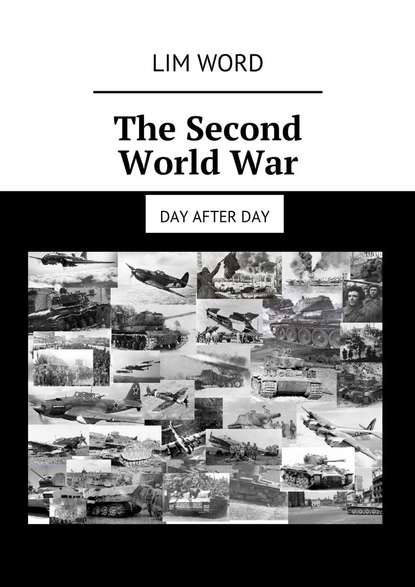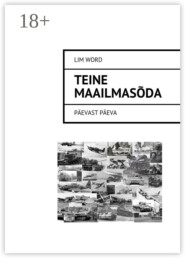По всем вопросам обращайтесь на: info@litportal.ru
(©) 2003-2024.
✖
The Second World War. Day after day
Настройки чтения
Размер шрифта
Высота строк
Поля
1. Quite a good Czech tank 38 (t). The “pigeon people” of Czechoslovakia never let them go against the Wehrmacht. In total, the enterprises of Skoda produced 1400 of them. The crew is 3—4 people, the forehead of the body is 25 mm high, the bottom is 12 mm., The hull is 15 mm., The forehead of the tower is 25 mm., The side of the tower is 15 mm. Weight 10 tons. Gun 37 mm, ammunition 72 shells, two machine guns, speed along the highway 48 km. h, cross-country 15 km. h, a power reserve of 230 kilometers.
2. Japanese fighter Ki-27 (in the USSR it was designated as I-97). Armament: two 7.7 mm. a machine gun with 500 cartridges per barrel. The speed of the earth is 395 km. h, at an altitude of 444 km. h. The range of flight is 627 km. From 1938 to 1942 produced 3,400 units.
3. BT-7. Armament: 45 mm. gun, 172 shells, one or two machine guns 7.62 (paired with a gun and aft). Booking: forehead housing 22 mm., Board 15 mm. (plus an outer layer of 4 mm.), the forehead, the side of the tower 15 mm. The speed is 72 km. h on wheels, 52 km. h on the tracks. Power reserve, 460 km. and 375 km. respectively, Crew 3 people. Weight 14 tons. Specific power 28 hp, ground pressure 0,85 kg. see (caterpillars). When driving on wheels, the front pair of rollers becomes controllable, the rear pair driving. Crawler – the steering wheel is removed, the drive from the transmission is sent to the “stars”, the control goes to the levers. The destruction of rubber bands – after about 100 km. mileage. The tank performed well in Khalkin-Gol, mediocrely – in the Winter War, differing in the worst side of the T-26 by its high fuel consumption, the noisiness, the complexity of the double drive. In the Great Patriotic War with varying success was used until 1942, after almost universally transferred to educational units. The last participation of BT-7 in military operations – the defeat of the Kwantung Army, 1945. From 1935 to 1940, 5330 vehicles were produced.
4. Ha-Guo, Type 95. Japanese light tank. Armament: 37 mm. gun, 75 shells, two 6.5 mm. machine gun. Booking: the forehead, the side of the body 12 mm., The forehead, the side of the tower 12 mm. speed on the highway 45 km. h, cross-country 25 km. h. Cruising range, respectively: 250 and 210 km. Crew of 3 people. Weight 7.5 tons. Specific power 16 hp, ground pressure 0,66 kg. See Manufactured 2300 machines.
5. ANT-40 (SB). High-speed (medium) front-line bomber, development of design bureau of AN Tupolev. Armament: four 7, 62 mm. machine gun ShKAS, 600 kg. bombs. Speed: maximum 450 km. h, cruising 375 km. h. The range is 2300 km. The crew is three people. Due to a fairly successful design, it was manufactured under license in pre-war Czechoslovakia: after annexation, all aircraft were placed at the disposal of the Reich and its satellites. Operated since 1936 in Spain, the Republican troops, where it was called “Katyusha” and (at the disposal of the francists) “Sofia”, also in the Khalkin-Gol, in the Winter, Great Patriotic War.
Most of the Security Council was destroyed in the first weeks of the Great Patriotic War; In addition, the lack of armor protection for the crew and vital units, and the lack of training of the flight crew, were reflected. Further, the ANT-40 was used as night bombers, to transport saboteurs to the rear of the enemy, as well as various kinds of cargo; ammunition, food, mail, etc. 6656 units were produced.
6. TB-3 (ANT-6). Soviet heavy bomber. Armament: from 4 to 8 7.62 mm. Degtyarev’s machine guns, the bomb load – normal 2000 kg of bombs, the maximum – 5000 kg. The speed of the land is 200 km. h, at an altitude of 180 km. h. The chassis are not retracted. The flight range is 3100 kilometers. The crew of 6—8 people. Successfully applied in the battles on Khalkin Gol, for their intended purpose, day and night, with the Soviet air force in the air, also for the evacuation of the wounded (15—20 people aboard), the delivery of goods. In the Winter War proved to be mediocre. It made up 25% of the Bomb Air Force by June 22, 1941, was based deep in the rear, so it almost did not suffer from Luftwaffe attacks. When daytime bombing targets carried heavy losses, but as a night bomber proved to be the best side. The Red Army was used up to the Battle of the Kursk Bulge. From 1932 to 1938, 818 vehicles were produced, completely ANT-6 was decommissioned in 1946.
7. One of the characteristic persons of the Stalin era – border guard Nikita Fedorovich Karatsupa, Hero of the Soviet Union. Birth – the village of Alekseevka, Zaporozhye region, Ukraine. Detained 338 violators of the state border. Personally, he destroyed “129 spies and saboteurs who did not lay down their arms.” In essence, this “right man” is a maniac killer of hundreds of unarmed Russian peasants who fled the Soviet regime and the GULAG abroad, possibly trying to explain the essence of their situation to the military detainee, but not receiving any response other than smirking or bullets.
Armed conflict between the USSR and Japan in the Khalkin-Gol
In the Japanese version, with Russian transcription, it sounds like “Nomon-khan jiken” – “The incident with Nomon Khan,” by the name of one of the local heights. Some historians consider fights at the river Halkin-Gol the Second Russian-Japanese war.
Since the twenties of last century Mongolia is a protectorate of the USSR and, nominally – a socialist country. Attacks on it are already considered a matter of the Soviet Union. Therefore, when in May 1939 militaristic Japan, unhappy with the demarcation of the border with the Mongolian People’s Republic, attacks Mongolian outposts near Lake Khasan, according to the Protocol on Mutual Assistance of March 12, 1936, the Red Army interferes.
Ground-based battles along the river Halkin Gol, considered by the Japanese as the “right” border with their puppet state on the territory of China (“above” Korea and more than three times), are conducted with varying success. The main events unfold in the air. Since May 22, for two days the Soviet fighter regiment is losing 22 I-15s, the Japanese – one. On an urgent basis, the pilots who showed up in Spain, as well as the newest I-16 and Chaika fighters, are called to the place of the conflict. From June 22 to June 28, the Japanese Air Force lost 90 aircraft, the Soviet Air Force lost 38 aircraft.
Since July 2, the Japanese ground group is moving into a large-scale offensive near Mount Bayan-Tsagan. In the battles participate up to 400 tanks and 300 aircraft from both sides at a time. Soviet troops quickly commanded by G. Zhukov. He manages to rectify the situation, although L. Beria sends the 1st rank commissioner L. Mehlis (a serial killer of the higher officers of the Red Army) to “check” the commander of the group of troops. The army commander’s psyche is stronger.
The Japanese side is losing 9,000 killed, almost all tanks and most of the artillery.
At the end of July, the intensity of military operations on the ground is declining. Again, fighting is in the air. Japan loses 67 aircraft, the USSR – 20. This is a prelude to a decisive blow by Soviet and Mongolian troops on August 20. The forces of the parties: the USSR-Mongolia – 30 thousand people, 500 tanks, 580 aircraft. Japan – 20 thousand fighters, 120 tanks, 450 aircraft. The army of the country of the Rising Sun is surrounded, crushed and destroyed. The day of the truce, on September 15, is crowned with an impressive air battle – 207 Soviet aircraft against 120 Japanese. Finally, “de jure”, the conflict ends in May 1942; the parties find a compromise on the basis of some geographic map found in the archives.
Losses of the parties: the USSR – irretrievable losses of 10 thousand people, 250 tanks, 210 aircraft. Japan and the Union of Manchukuo, according to the averaged data – 36 thousand people, 300 tanks, 400 aircraft.
The Soviet-Finnish War of 1939—1940
Ideas of Great Finland, uniting the peoples of the Finnish-Ugric group; Finns, Karelians, Estonians, from the Gulf of Bothnia to the Ural Mountains, are spreading with the separation of Finland proper from Russia in 1918. The Government of Suomi sends a petition to the warring Germany; conclude a Brest peace with the condition of joining Finland (an ally of the Austro-German Empire), East Karelia.
In the course of their own civil war, on April 29, 1918, the White Finns capture Vyborg, arrange the genocide of all people who do not speak Finnish (retired military, schoolboys in Russian uniforms, even Poles). Three thousand people die.
On May 15, 1918, the Finnish government declared war on Soviet Russia. Its troops occupy, in particular, the Russian, from the 16th century, Pechenga, rename the name of this village in “Petsamo”. Later, large deposits of nickel ore will be explored here, since 1935 their industrial development by Anglo-American corporations will begin.
The Finnish military partially block Petrograd, contributing to the first great famine in this city (according to averaged data, one hundred thousand people become victims of it, as well as “red” terror). At the rate of Mannerheim, a plan for “national uprisings” is being developed, Finnish instructors are being allocated to create centers of insurgency. However, the plans of the Field Marshal to conquer East Karelia, the Kola Peninsula, the offensive against Petrograd, Germany does not support. After the Vyborg tragedy, any joint operations to overthrow the Bolshevik government along with the Finns, the White Army refuses to conduct either.
By May 1920, parts of the Red Army were eliminating the puppet North-Karelian state. In October of the same year, Finland and the USSR signed the Tartous Peace Treaty, according to which Russia was losing part of its territories. However, in 1921 Helsinki unleashed the second Soviet-Finnish war, by forces of “forest partisans” committing acts of sabotage and killing of supporters of Soviet power. The fighting ends in March 1922, a document is signed to ensure the inviolability of the Soviet-Finnish border. About 30,000 people dissatisfied with the new order go to Finland and, up to the end of the 1920s, armed groups formed from them, make raids on Soviet territory.
Whatever it was, the mood in Finland does not seem friendly to the Soviet government. His proposal – the removal of the border from Leningrad at the expense of Finland, in exchange for twice the size of the areas of East Karelia. Rent of the island of Hanko to create a Soviet military base. Disarmament and demolition of the “Mannerheim Line” on the Karelian Isthmus. Finland rejects these conditions.
Military operations begin after the delivery of an ultimatum, on November 30, 1939, from shelling (ships of the Baltic Fleet) and the bombing of Helsinki. The Soviet Union is excluded from the League of Nations. European countries supply Suomi with weapons, including free of charge (350 aircraft, 500 guns) and volunteers. For two months the columns of Soviet troops advancing along the forest roads are being cut by Finnish skiers, surrounded and destroyed. This is no longer the Halkin Gol. In February, having saturated the troops with heavy artillery and tanks, having increased the norms of food allowance, the USSR is making progress in the breakthrough of the Mannerheim Line; On March 13, Soviet troops enter Vyborg. The world lies. Irrevocable, severe losses of the USSR – 130 000 people, 650 tanks, 640 aircraft; Finns – 26 000 people, with 450 000 refugees, 62 aircraft. From the Finnish captivity, 4,354 people return, and are being filtered by the NKGB GUGB. 450 of them are released, the rest receive from 5 to 8 years of camps.
This military operation could have a special meaning if the USSR kept Petsamo (Pechenga) with the reserves of nickel ore, much needed by Germany’s military industry. However, the international community, including, above all, the UK, is strongly opposed. The area Petsamo returns to the Finns, and they organize a large-scale supply of nickel to the Axis countries.
Pechenga will join the Russian Federation only in 1944.
Among the advantages in the combat training of troops, after such a harsh school, is the abolition of the institution of political commissars, the experience of breaking through long-term fortifications, the winter war as a whole, and the return to production of a submachine gun (PAP).
Cons, in addition to the hardest losses – the German government understands that, in principle, is able to achieve all-round success in the war against the “colossus on clay feet”.
1. The Dot of the Mannerheim Line
2. Howitzer B-4
1. The Dot of the Mannerheim Line
2. Howitzer B-4, caliber of 203 millimeters. The main hero of the Finnish war. The nickname “Karelian Sculptor”, for the fact that this instrument turns Finnish dots into a kind of avant-garde statues. The parameters of Finnish DOTs are “million”: the length is about 40 meters, the thickness of the walls of reinforced concrete is 2 meters. The result of action B-4 – if not the penetration of the walls, then the psychological impact on the defenders of the DOTs. Many of them, after a long bombardment of the B-4 went crazy.
The entry of the Baltic republics into the USSR
In October 1940, the Soviet Union invites Estonia, Latvia and Lithuania, under a mutual assistance agreement, to deploy a military contingent of 25,000 troops on their territory to defend themselves against Hitlerite Germany. It is already clear that the Red Army is inclined to achieve its goals, regardless of any losses. Two weeks later, the governments of these countries are accused of collusion with Germany (which is partly true), repressions against foreigners (Poles, etc.) and are shifting. In the summer of 1940, following the results of nationwide voting, the republics are formed by communist governments and adopt declarations of entry into the Soviet Union; which are immediately approved by the Supreme Soviet of the USSR.
According to the documents of the NKVD of June 17, 1941, in Lithuania, 5,663 people, mostly secret police officers and “classical capitalists”, were subject to detention, 10,186 in Latvia, 5,624 and 9,547 in Latvia respectively, and 3,179 and 5,979 in Estonia.
President of Lithuania Antanas Smyatona wisely emigrates to Germany, then Switzerland and the United States. His Estonian counterpart Konstantin Päts is deported with his family to Siberia, receives 25 years of camps, since 1942 is kept in a prison psychiatric clinic, he died there in 1956. The head of Latvia, Karlis Ulmanis convinces the people that “friends have come”, actively cooperates with the new, pro-Soviet government, and in particular, publishes the “Law on the fight against wrecking”. Somewhat later he begins to understand the situation, asks the Kremlin for permission to travel to Switzerland, but eventually ends up in the NKVD camp near Krasnovodsk (Turkmenistan), where, in 1942, he dies.
The Second World War
Occupation of Poland
The territories of Poland, acquired by Germany at the expense of Germany under the Treaty of Versailles (West Prussia and part of Silesia), prevent the Reich from uniting with East Prussia, the “cradle of German militarism”, its sacral center. After negotiations on the creation of a land corridor, or at least the transit of goods through Poland without bureaucratic obstacles, September 1, 1939, the invasion begins simultaneously from Germany, Slovakia and Prussia. The Polish Air Force, having existed for three days, shoots down 130 Luftwaffe aircraft. On September 22, the bombing of Warsaw begins: 1,150 aircraft drop 4,500 tons of bombs, and on September 28 the Polish military command (the civil government takes refuge in France) signs an act of surrender.
On September 17, Soviet troops enter Poland to restore Western Belorussia and Western Ukraine, captured during the Russian-Polish war of 1920, to protect the Belarusians, Ukrainians and Jews who are there, respectively. The main idea: if Poland shows enough courage in confronting Hitler, it is actively assisted by France and England, the Wehrmacht meets a worthy rebuff, the status quo is observed on the part of the USSR. The obvious victory of the Germans, inclined, of course, to occupy the entire territory, means the entry into the game of the Red Army.
Part of Poland – the Vilna (Vilnius) region with 490 thousand inhabitants are transferred to Lithuania. Some territories pass to the satellite of Germany – Slovakia. Refused to accept Soviet citizenship 78,000 refugees (including Jews) from Germany occupied by Poland, are deported back, or receive 20 years of camps.
Losses of the parties: Poland – irretrievably 63 000 soldiers and officers in the battles with the Wehrmacht, 420 000 in German captivity, 230 000 in the USSR (ordinary and non-commissioned officers are dismissed to their homes, in 1942 most of them, in agreement with England, bypassing Iran, joins the British forces, forming the army of General Anders or Sikorsky), as well as 357 aircraft of different types. Germany – 15 000 killed, as well as 319 armored cars and 285 aircraft (as a result of air crashes, air defense and fighter operations). Soviet troops (RKKA) – 2,000 dead, 17 tanks and 10 aircraft. Poland: irretrievable losses in battles with the Red Army – 3000. Slovak army: 18 people.
So, in the war included England and France, who acted as the guarantor of Poland’s security, but the first six months of fighting on their fronts are almost not conducted. Flyers prefer to scatter leaflets (“confetti”), rather than bombs, over postings of the enemy, “We will not shoot at you if you do not shoot us”.
Hitler is interested not so much in the island of the foggy Albion, as in the English dominions. Even if you capture London, the government will move to the territory of one of the colonies, and the fight will continue indefinitely. Honorary peace with the Anglo-Saxons, the Nordic race, equal, according to the Fuhrer’s admission, to the Germans themselves, the delineation of the territories of influence is what Germany wants.
Benelux countries
Denmark and Norway. They are threatened with the capture of two centers of power: England and Germany. Denmark tends to the protectorate of Germany, the leaders of the country give the order not to resist the invasion; which took place in March 1940, and cost the life of thirteen Danish and two German soldiers. The Reich acquired a good supplier of agricultural products, a dozen of warships, as well as a 6,000-strong volunteer corps, who fought on the Eastern Front until his disbandment in 1943.
In April 1940, German warships attacked the British-assisted Norway and, by June 16 of the same year, seized it. The irrevocable human losses of the opponents are approximately equal: the Norwegians have 1,400 men, and also 60,000 prisoners, the British 1800, French and Polish 500, Germans about 4000. Allied forces are deprived of a total of 15 warships, including the aircraft carrier, Germany – 34 large and 10 small; these losses make the landing operation in the UK questionable. As a result of the submarine war, England is losing 485 ships, which is one third of the merchant fleet: Germany exchanges them for its 9 submarines.
On May 10, 1940, Belgium and Holland receive an ultimatum from the German command with reproaches in violation of neutrality – the unhindered passage of British aircraft over their territory, as well as the construction of long-term fortifications facing Germany. The note calls on Holland not to prevent the German troops entering the country, not as enemies. which, however, by this time already are on the land of the Netherlands. The government of the country of dams and cheese requests assistance from the British and French, their expeditionary corps is being put forward to establish contact with the Dutch.
German paratroopers seize the strategically important bridge from Rotterdam, which allows German tanks to block all large Dutch infantry units. Under the threat of bombardment of Rotterdam, a demand is demanded for full surrender of the state. The ultimatum is accepted, however, as a result of a mistake, or deliberate action of 60 Heinkel 111 bombers, 97 tons of bombs are dropped on the city. Holland surrenders five days after the outbreak of the war. Losses of the Dutch side: 2330 soldiers and officers, 70 aircraft, (68 Typhoons lost by the British Air Force), as well as 2,000 civilians, German – about 3,000 military, 275 aircraft.
The idea of an ambitious German officer, Erich von Manstein, is to attack the Anglo-French army, superior in number (4 million to 3 million Wehrmacht fighters), through the mountain (Belgian) Ardennes, from the north, through the forces of a few but unified tank units, the Fuhrer.











